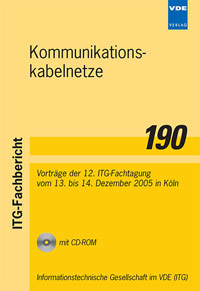Lowering the Cost of Broadband Access in Multi-Dwelling Buildings using Multimode Fibre
Conference: Kommunikationskabelnetze - 12. ITG-Fachtagung
12/13/2005 - 12/14/2005 at Köln, Germany
Proceedings: Kommunikationskabelnetze
Pages: 4Language: englishTyp: PDF
Personal VDE Members are entitled to a 10% discount on this title
Authors:
Kuyt, Gerard; Matthijsse, Piet (Draka Comteq Optical Fibre, Eindhoven, The Netherlands)
Burgmeijer, Jan (TNO ICT, Delft, The Netherlands)
Abstract:
Lowering the cost of broadband access in multi-dwelling buildings for residential premises is an opportunity. In this case we have the combination of high customer density, lack of right-of-way problems and significant market share, especially in Europe and Asia. In addition, the experience with multimode fibre based enterprise networks is valuable. Transferring this into an FttH solution for multi-dwelling residential buildings results in an attractive architecture, promising cost advantages based on the low connectivity cost of this fibre type. The recent break-through of wide-window fibres offering high bandwidth up to the 1550 nm telecom wavelength region makes this solution also future proof. TNO ICT, as an independent research institute in Europe, has appraised the capital expenses of this architecture and referenced it with a residential case using an access switch based point to multi-point network applying both single mode and multimode distribution fibres. All cases assumed to support triple play services. Using current European market prices, active point-to-point Ethernet with first mile multimode shows a less then 10 % cost benefit compared with end-to-end single mode fibre. With list prices however, this benefit raises to more then 30 %. Filling in the recommendations for further cost decreasing will make the multimode fibre in multi-dwelling buildings a cost attractive and viable alternative in the near future.


